Summer projects on (or near) your corner
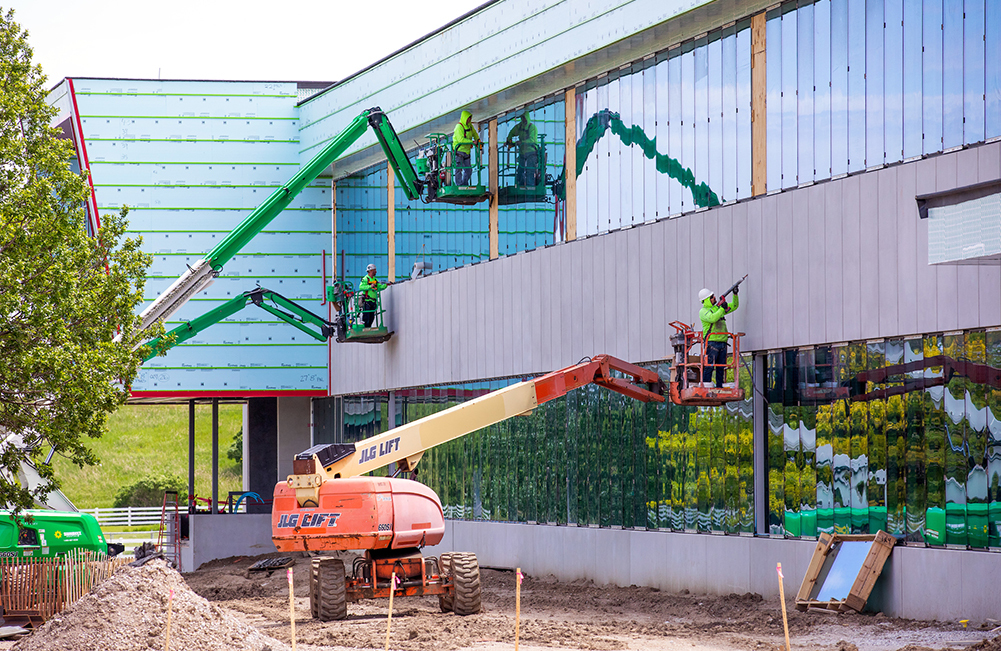
Workers seal seams between panels this week near the front entrance to the new Veterinary Diagnostic Laboratory. Photo by Christopher Gannon.
Construction teams seemingly are replacing students on campus for the next 10 weeks or so to take advantage of Iowa State's smaller summer student body and tackle some impactful projects. Inside talked to project and construction managers in facilities planning and management for a snapshot of summer projects -- and an update on a few with a longer timeline. With our thanks, this is not a comprehensive list of all the projects those teams are coordinating!
Summer window
Design, Carver auditoriums
Work on refurbishing two heavily used auditorium classrooms -- in Carver Hall and the College of Design -- began last week and will wrap up by early August. Both are receiving new flooring and seats, and accessibility and technology upgrades. The walls and ceiling in 101 Carver also will get upgrades and LED lights. The cost, $415,000 at Carver and $290,000 at Design, is split between the provost's office and facilities overhead use funds.
Central campus road replacements
Two short sections of campus roads are closed for replacement: Union Drive along the north side of Lake LaVerne and the middle section of Farm House Lane from Troxel to Curtiss halls (access remains to parking lots adjacent to both buildings). Neither requires underground infrastructure improvements. Farm House Lane will be widened to 21 feet so oncoming vehicles can pass each other safely, and existing bicycle parking will be replaced. A sidewalk will be added to the north side of Union Drive between Morrill Road and the Welch Road intersection. Lot 74, reserved parking along the lake, will relocate to the north side of the road to open visual access to the lake. Combined, the two projects are $1.15 million, mostly state institutional road funds, with ISU parking sharing the cost of the Union Drive changes.
New RV location for football fans
Work began in April to convert a grass lot east of University Boulevard to a 337-stall lot for RV tailgaters on football gamedays. Features include a 10-by-55-foot concrete pad and electrical hookup for each stall, lights, asphalt drive lanes through the lot and grass lawn between pads. Stalls that are ready by the end of May will be seeded, and those available later will be laid with sod.
This $9.1 million project includes a 12-foot-wide pedestrian bridge over Worle Creek, at the south end of the RV lot, to provide safe stadium access to fans who park in lots near the Veterinary Medicine college and a second access to this area for emergency vehicles. Athletics department funds will cover this project.
More Friley roof
2022 is the second of a two-summer project to replace Friley Hall's slate roof with asphalt shingles and replace gutters and downspouts as needed. Flat rubber and metal roof areas also are being redone. Last summer, the roof was replaced from the southwest end of Friley through the loading dock area across from Lake LaVerne. Phase 2 starts in the vicinity of Friley Windows dining center and continues north to the end of the residence hall. This project includes all work on the top floor dormers -- window replacement, roof and siding. The dormer windows weren't replaced in a three-summer window project (2018-20). Work will conclude by the end of July. The $5.9 million cost is covered by dormitory system improvement funds.
West parking expansions
Parking lots 1 (south of State Gym) and 10 (west of Town Engineering) will grow by at least 60 stalls each prior to construction of the Therkildsen Industrial Engineering Building for the industrial and manufacturing systems engineering department on the west end of Lot 3 (northwest of Beyer Hall). The parking lots project will be bid in late summer, and the intent is to complete the Lot 1 expansion and a necessary realignment of the Sheldon Avenue extension by the end of December. Lot 10's west expansion is scheduled for next summer. Expanding the two lots will replace the stalls lost in Lot 3. The $2 million pricetag will be shared by ISU parking division and the Therkildsens' building gift.
College of Design exterior windows
Yes, the College of Design facility contains a LOT of windows. This project covers exterior windows original to the building on six levels (ground through five); it doesn't include the barrel window running the length of the roof or the curtain window at either end of the center atrium. The 44-year-old window ribbons will be replaced with tinted, high-efficiency glass windows, though product delivery challenges will delay that work until late August. Weather permitting, each side of each floor should require seven workdays to replace the length of windows, necessitating short relocations within the building for staff and faculty this fall. The $2.85 million project will begin around June 1 with its other component: replacing the caulk between expansion joints in the building's concrete panels to seal out moisture.
Wrapping up this summer
University Boulevard pedestrian bridge
The elevated walkway connecting the east concourse of Jack Trice Stadium to parking lots east of University Boulevard is about 70% complete and should be done by late July. The east ramp is built above a designated no-use corridor in ISU's southeast recreation fields. Steel spans across the road will be lifted into place the week of June 27. To accomplish this, daytime traffic will be limited to one lane in each direction, and from 7 p.m. to 7 a.m. University Boulevard will be closed. The project includes a fence along the west side of University Boulevard between South Fourth and South 16th streets that matches the Reiman Garden fence and compels fans to use the designated crossing sites. To promote year-round use of the pedestrian bridge, the project also includes a sidewalk outside the northeast corner of the stadium, hugging the hillside, that connects the north plaza area to the bridge.
Soults Family Visitors Center in the MU
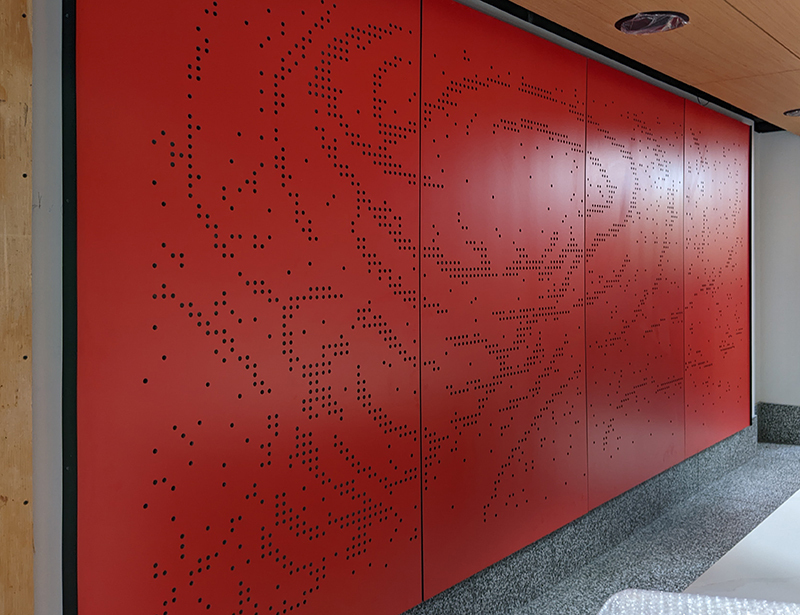
This backlit Cyclone panel is a new feature at the front of the Soults Family Visitors Center.
The ground floor presentation center, where campus tours begin for prospective students and their families, was closed spring semester for a major remodel and a modern look. The project includes new seating, flooring, ceiling, lighting, paint and state-of-the-art presentation technology, and a west exterior door for an easy transition to the walking tours. The entry wall, formerly home to a "Welcome to Iowa State" Sticks mural, will feature an LED wave wall and a backlit Cyclone panel. The $1.8 million project also includes converting an adjacent kitchenette to a meeting room, renovating the nearby admissions staff office and converting two gender restrooms into six individual unisex restrooms. Due to delivery delays on several construction items, the estimated window for use of the new spaces is early August.
Iowa State Center northwest lot
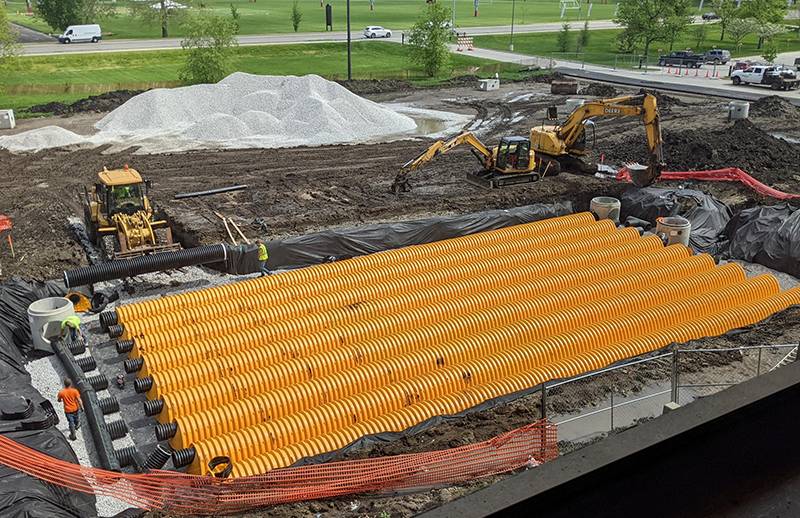
One of two detention basins being installed beneath the northwest lot to handle stormwater.
This project is expanding the parking areas north of the Scheman Building and west of Fisher Theater. About 325 stalls -- roughly 10% of them ADA compliant -- will be added to the 150 stalls provided in the two former lots, more than tripling the parking in this area of the Iowa State Center. The surface will be asphalt with concrete curb and gutter. The west half of the lawn between Fisher and Stephens Auditorium will be converted to a drop-off area, and the Beach Avenue exit will move south to align with Sunset Drive. The project includes additional sidewalks and lighting and two 60-by-100-foot underground stormwater detention basins. Despite a wet April, the project remains on schedule for completion in early August. Athletics department funds will cover the $5.55 million cost.
Ongoing projects
Power plant: coal boiler conversion
The remaining two coal boilers in the ISU power plant, which have 15-20 years of service left, will be converted for natural gas burning, one each this summer and next. Three other natural gas boilers were installed in 2015, and the university can operate with three boilers this time of year. The process for each boiler conversion includes removing the equipment that supplies coal and limestone to a boiler, installing gas burners and control systems, and expanding the natural gas supply lines into the facility. Demolition of boiler #1 components is occurring now. In fall 2023, when the second boiler conversion is complete, a shared collection system for the ash byproduct will be removed from the power plant, and two nearby coal storage lots will be restored. The $16 million cost will be covered by ISU's utility reserve fund and an internal university loan.
Veterinary Diagnostic Laboratory, phase 1
A new home for the Veterinary Diagnostic Laboratory, under construction between U.S. Highway 30 and the College of Veterinary Medicine, is about halfway to completion, heading for occupancy in early fall 2023. About 95% of the building is enclosed. Inside, wall framing and drywall, mechanical and plumbing work, and installation of a monorail is progressing.
In February, university leaders received state Board of Regents approval to begin planning for a 69,000-square-foot, estimated $64.3 million phase 2 to the lab. The second phase would allow all VDL operations to be in one facility.
'Roll out the cardinal carpet,' as orientation returns in full
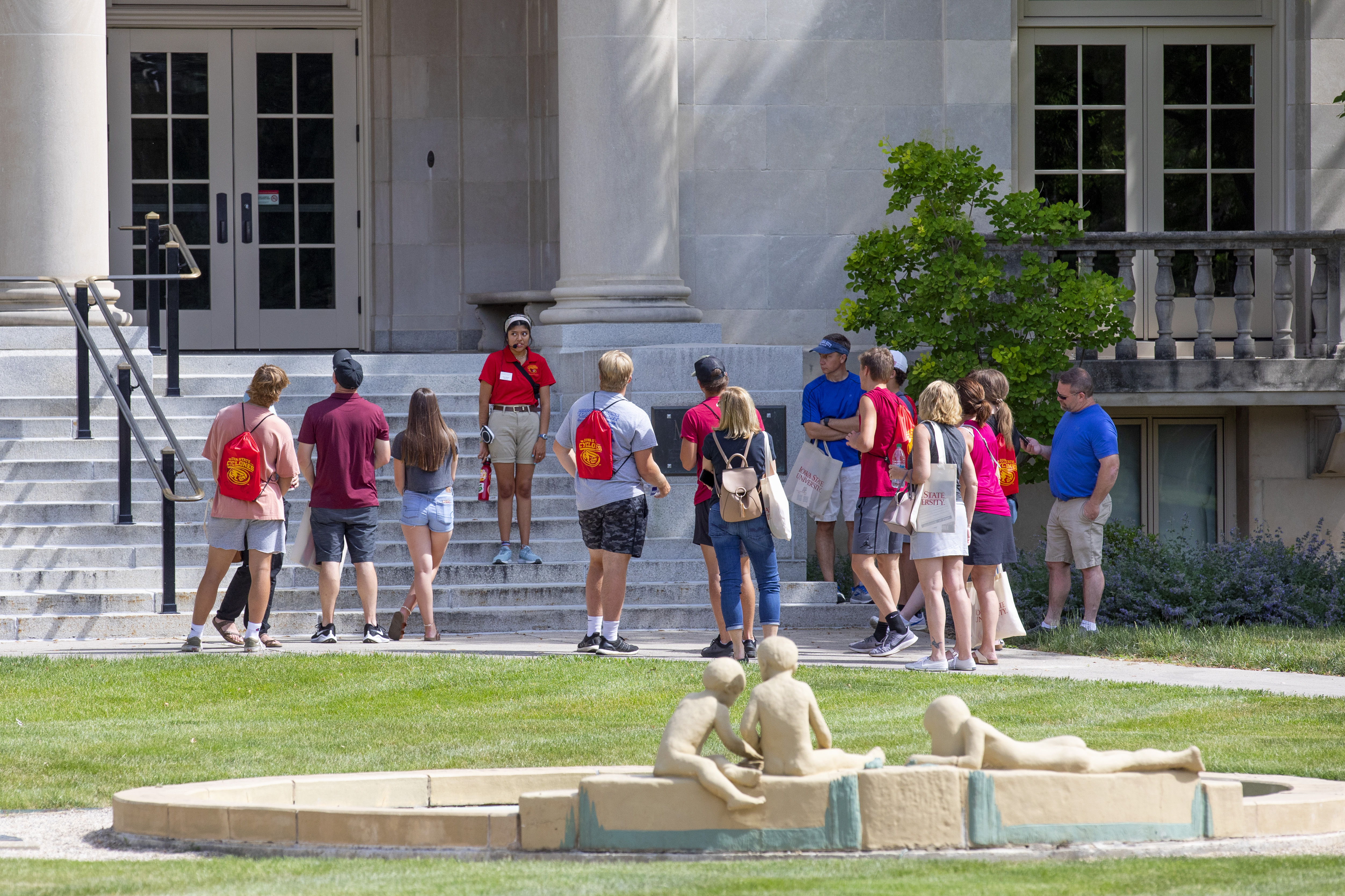
A group of summer orientation students on a campus tour in 2016 stop to listen to a Cyclone Aide outside MacKay Hall. Photo by Christopher Gannon.
Student orientation is returning to its usual form this year for the first time since 2019, offering Cyclones-to-be an opportunity for a two-day in-person introduction to Iowa State.
In 2020, all orientation activity was online due to the COVID-19 pandemic. Last year, orientation had a required online portion that included academic meetings and registering for fall classes in a virtual session with an advisor, with an optional one-day "OnCyte" campus orientation. About half of incoming students opted for the campus orientation.
The online option continues this year, but the 90% of students who plan to visit campus for orientation will enjoy a full schedule of in-person meetings and activities over two days, with an opportunity to stay in campus housing, said new student programs director Sarah Merrill.
"We're really excited to have students and their families back on campus experiencing what Iowa State's all about," she said. "It's clear to me students and families can't wait to step foot on our beautiful campus and start making that connection."
More than 5,000 first-year students are planning to participate in OnCyte orientation, Merrill said. Students typically bring two family members with them, so the orientation sessions will involve about 15,000 visitors throughout June. Sessions will be held on weekdays, along with two planned to begin on a Sunday (June 5 and 26). Overnight stays will be in Maple Hall, and orientation parking is in Lot 63 east of the Maple-Willow-Larch complex. Friley Windows dining center will be open for breakfast, lunch and dinner.
The online alternative likely is a mainstay for years to come, Merrill said, because it makes orientation more accessible to students who live far away or are unavailable in June.
The up to 300 students at a time who opt for OnCyte orientation will have a busy agenda that includes meetings with faculty and staff in their college, tours with Cyclone Aides, getting their ISUCard, social activities and a wide selection of informational sessions. Newly added is a Day Two resource fair at the Student Innovation Center, where students can get personalized attention from more than 30 university departments who will have a representative on hand.
In addition to acclimating incoming students to campus, orientation helps seal the deal for some. Many students attend orientations at multiple institutions to help make a final decision about where to enroll, Merrill said. She urges faculty and staff to make a special effort to be friendly, helpful and clear (no acronyms) with visiting students and their families.
Patience may be especially important this year. Students might not have the same frame of reference for what orientation is like since it's been different the past two summers, and their own paths through high school have been unique, as well. There may be more questions than usual, Merrill said.
"Really bring out that Cyclone spirit and roll out the cardinal carpet to help these students prepare to be successful at Iowa State," she said.
Every effort counts because hundreds of faculty and staff impact the orientation experience, Merrill said, from facilities crews maintaining the grounds and dining staff serving meals to faculty meeting with students and advisors helping them sign up for fall courses.
"Orientation really is a community effort," she said.
Welcome
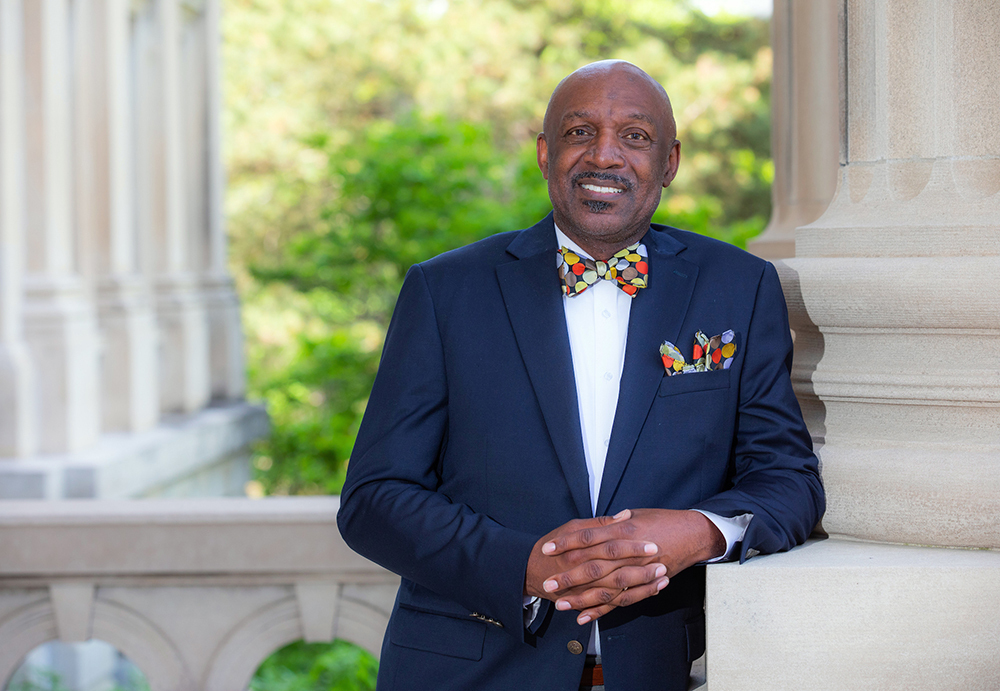
Photo by Christopher Gannon.
Carl Wells started May 16 in the university position of director of equal opportunity and Title IX coordinator.
He comes to Iowa State from the University of South Carolina, Columbia, where he served as senior advisor for civil rights and affirmative action and recently completed a one-year assignment as interim director of the office of equal opportunity programs and Title IX coordinator. In sum, he served more than 20 years at the university in roles focused on equal opportunity, civil rights, affirmative action, Title IX, diversity and inclusion. He also was an adjunct professor of management and taught master's-level courses in employment law, and he directed the university's for-credit gospel choir.
Reporting to the office of the president, Wells will oversee the office of equal opportunity, responsible for supporting equal access to work and educational opportunities, including:
- Investigating complaints of discrimination and sexual misconduct
- Ensuring compliance with the law
- Providing educational programs to campus
Wells earned a Ph.D. in public health administration with an emphasis in human resources and employment law (2010) from the University of South Carolina; a master's degree in divinity with an emphasis in counseling (1991) from Emory University, Atlanta; and bachelor's degrees (1987) in communications and music from Winthrop University, Rock Hill, South Carolina.
His office is in 3410 Beardshear. He can be reached by phone at 294-7612 and by email at wellscr@iastate.edu.
Senior VP Cain will retire this fall

Pam Cain
After serving the university for 15 years, senior vice president for operations and finance Pam Cain will retire early in the fall semester. Cain shared the announcement in a May 24 memo to staff in the division of operations and finance.
"Pam has been an incredibly steady, hard-working and reliable presence on my senior leadership team," said President Wendy Wintersteen. "Her professionalism and devotion to our Iowa State community has been unwavering since she joined the university 15 years ago."
Cain's career spans more than 42 years, all in administrative and financial leadership roles for the university, the state Board of Regents and the state auditor's office. In 2007, Cain came to Iowa State as associate vice president for business and finance. Beginning in 2017, she served in interim roles as senior vice president, and in 2020 was named senior vice president for operations and finance.
A national search will be announced in the next few weeks.
Leaders take strategic plans, building proposal to regents next week
An Iowa State nine-year strategic plan, 30-year strategic facilities plan and a design proposal for a new academic building on the west side of campus are on the agenda when the state Board of Regents meets next week in Iowa City. The agenda is on the board's website, and all public portions of the meeting will be livestreamed there, too.
The board will meet Tuesday morning, May 31, through midday Thursday, June 2, but the first day and a half will be occupied with annual evaluations for regent institution heads and the board's executive director, Mark Braun.
Strategic plan
Iowa State's next strategic plan outlines an annual priority-reviewing and planning process for the next nine years (FY23-31). It's driven by five aspirational "to be" statements and shaped by the university's four areas of excellence as a public land-grant: innovative solutions, knowledge and discovery, education experience and community engagement. As proposed, a director of strategic planning and initiatives, who reports to President Wendy Wintersteen, would oversee the annual process that involves the campus community and external stakeholders to review and assess priorities and propose projects -- one to multiple years -- that move Iowa State toward its "to be" statements. The plan includes success metrics for each statement.
Strategic facilities plan
About three years in the making, Iowa State's strategic facilities plan succeeds a 1991 campus master plan. It provides high-level, modern guidelines for investing in and replacing facilities over 30 years that look at cost and erasing deferred maintenance but also at sustainability factors. It also identifies specific buildings that are key pieces of the plan; some for renovation, some for demolition and some to be used up as swing buildings -- temporary homes for employees whose buildings are in the first two categories.
The strategic facilities plan preserves the central campus green space and assumes no major changes to student enrollment, the campus housing footprint or financial support (including research support). It focuses on the main campus' academic and research facilities, and excludes nearby agricultural properties.
Following regents approval, websites will be created for the strategic plan and the strategic facilities plan.
Therkildsen building plans
Iowa State will present a project description, building design and budget for the proposed $54 million Therkildsen Industrial Engineering Building. If approved, this is the final green light required from the regents. The proposed four-story (42,600 net square feet) facility situated northwest of Beyer Hall will provide teaching and research labs, classrooms and offices for the department of industrial and manufacturing systems engineering. The department currently shares Black Engineering with the mechanical engineering department. A 2014 College of Engineering space study identified critical space needs for both departments. The cost of the project will be covered by a $42 million gift from alumni C.G. "Turk" and Joyce McEwen Therkildsen and university funds.
Improvements to Iowa State Center lots
Iowa State will seek board permission to begin planning for an estimated $25 million in underground infrastructure and paving improvements to parking lots between Hilton Coliseum and Jack Trice Stadium. This first phase would place new water, power, gas, phone, storm and sanitary lines, to support future development, under about 80% of the lot area south of Center Drive. The project also would raise the lots above the 100-year flood plain. Six lots near Center Drive -- A1, A2, B3, B4, C3 and C4 -- are designated for a future phase. A combination of university and athletics department funds would be used for this project.
Other business
In other business, the board is scheduled to:
- Direct the universities to, when they're complete, submit FY23 salary policies to Braun for final approval.
- Review Iowa State's request for a new B.S. program in healthcare management in the department of management and entrepreneurship.
- Receive an update on campus participation rates in the board's required online free speech training during spring semester.
- Elect a board president and president pro tem for two-year terms, through April 2024.
Support grows for responding to student well-being needs
Reflecting a national trend that predates the pandemic but has accelerated in its wake, mental health needs are greater than ever among Iowa State students. In response, faculty and staff have a new resource for helping students (and colleagues) who may be struggling, one of a variety of trainings this summer focused on identifying and addressing well-being concerns.
Bolstering programs that give faculty and staff guidance and resources to respond to mental health issues is essential, student wellness director Brian Vanderheyden said. Broadly building that capacity recognizes that efforts to improve student well-being need to extend across campus, beyond units specifically geared toward health and wellness. Ideally, support for seeking help can stem from relationships with instructors, advisors and student affairs staff. And a peer is often a student's first source for advice, which is why trainings also are available to students.
"One person in an office can't impact the entire system that affects well-being," Vanderheyden said. "We have to engage in more of a public health, systemwide approach."
New training offered
A program designed with that broader approach in mind is the new training and screening tools offered through Cyclone Support, which launched last fall as a campaign to promote the mental health resources available to students.
The 90-minute Cyclone Support training is designed to give faculty and staff practical and tangible tools to help students identify mental health and well-being needs earlier and connect them with resources, Vanderheyden said. The training and the companion toolkit use evidence-based practices grounded in the screening, brief intervention and referral to treatment (SBIRT) model.
Participants learn how to use the Cyclone Support self-assessment tool, which screens for concerns in a dozen different well-being areas, and embed it in their regular contact with students. They also receive tips -- including suggested questions, statements and responses -- for motivating students to seek help, along with an overview of the varying levels of support from self-help apps and peer-based services up to more specialized treatment options.
"Not every student needs individual counseling," Vanderheyden said.
The SBIRT model provides a useful framework for brief discussions faculty and staff have with students about well-being issues, he said.
"It's not about adding work for people. It's more about doing it differently. Faculty and staff are already meeting with students and having conversations like these. I hear about them all the time," he said.
Cyclone Support training sessions in 3580 Memorial Union are scheduled for July 13 and 29 (10:30 a.m.-noon) and Aug. 2 (2:30-4 p.m.). Sign up or request the training for a group on the student student health and wellness website.
Spiking concerns
Research consistently shows that student well-being is an important factor in academic success, said student counseling services director Kristen Sievert in a presentation to the Professional and Scientific Council earlier this month. That's evident in tuition appeals and out-of-term withdrawals, 83% of which from 2018 to 2021 had a connection to health or well-being, primarily mental health, she said.
"If a student is not emotionally, mentally, physically, socially well, it's going to be really difficult for them to be academically well and perform to their highest standards," she said.
And unfortunately, perhaps in part due to lingering effects of the pandemic, data from surveys and ISU service providers continue to show mounting concerns about student well-being, Sievert and Vanderheyden said in the presentation.
At the Thielen Student Health Center over the last year, diagnoses of anxiety increased 10% and diagnoses of attention-deficit/hyperactivity disorder increased 31%. In fall 2021, 52% of psychiatric visits to the center were classified as "complex," compared to 19% the year before. The number of cases at student counseling services that required the care management team, a higher level of support, increased to 162 in 2021, up from 105 in 2019 and 138 in 2020.
A national health assessment this fall showed that ISU students, 1,035 of who participated in the survey, aren't alone in struggling. Nearly four out of five ISU respondents said the pandemic increased their overall levels of stress.
"Students are struggling with their mental health. They're having a hard time," Sievert said.
Other training options
Vanderheyden said the spike in mental health issues was clear right away last fall and was the impetus of the Cyclone Support program.
"We were anticipating an increased level of student well-being needs, but it was kind of like, 'Holy cow, this is a lot,'" he said.
But the trend toward a greater need for mental health services has been present for years. A three-year grant Iowa State received in 2018 helped produce two other mental health support trainings available to faculty and staff this summer, QPR and RESPOND, both of which focus on suicide prevention.
QPR, which stands for question, persuade and refer, is a one-hour course focused on identifying the warning signs of a suicide crisis and how to respond. No training times are set for the summer, but it is available by request for groups. RESPOND is a more in-depth 8-hour program that will be offered June 8 and 15 and July 7 and 12 (8 a.m.- 4 p.m., Hach Hall auditorium). Register or request trainings online.
ISU WorkLife also is hosting a daylong mental health training opportunity for faculty and staff this summer. Mental Health First Aid focuses on identifying, understanding and responding to signs of mental illness and substance use disorders. Register online for the training July 27 (8 a.m.-5 p.m., conference room, 4-H Building).
All three programs have similarities, including promoting effective strategies to encourage connection such as active listening and asking open-ended questions, Vanderheyden said. The trainings are useful for encouraging colleagues to seek needed help, too.
"They're all about your role in helping a person in distress. They're all evidence-based, and they're all great," he said.
Training available as New Quizzes set to launch in Canvas
Starting next week, all instructors will have access to New Quizzes, the updated quiz engine in Canvas. There are many opportunities this summer to learn about and try New Quizzes.
The shift away from the existing quiz engine, Classic Quizzes, will be a two-year process, giving instructors the flexibility to navigate the transition at their own pace. For the next year, instructors can create new assessments with either tool. Beginning next summer, they can administer an assessment through Classic Quizzes but won't be able to build new ones. The classic format will be eliminated June 30, 2024, though instructors will be able to migrate quizzes to the new format even after that date.
The change, which is required by Canvas, will introduce new features to assessments offered in the learning management system, including an updated interface, mobile-friendly design, new question types (such as hot spot, stimulus, categorization and ordering questions), print-out capacity, options for student accommodations and more.
A list of essential things to know posted by the Center for Excellence in Learning and Teaching (CELT) provides an overview and a rundown of what features are in the process of being improved, added or fixed. A continuously updated comparison between the old system and the new system provides a detailed outline of the differences.
Feedback from the small group of instructors who piloted New Quizzes during the spring semester indicated they appreciated the accommodation options, randomizing the order of questions and answers, and new question types.
CELT instructional specialist Lesya Hassall said instructors are encouraged to take their time to learn about New Quizzes and create a Canvas course shell to experiment, known as a sandbox. She advised those who are ready to start using New Quizzes to be strategic about their first steps. Instructors may want to avoid using the new system this fall when teaching courses with more than 50 students, for instance.
"Courses with smaller enrollment and simple quizzes that do not rely heavily on formula-type questions and exportable quiz data reports are a good way to start," she said.
One-hour general training sessions will be available June 2 at 10 a.m. and June 6 at 2 p.m. (2030 Morrill or via Webex). General trainings also will be offered Aug. 8 (1 p.m.), Aug. 9 (10 a.m.) and Aug. 16 (2 p.m.), and virtual open labs with a special emphasis on New Quizzes are available throughout the summer, Mondays (8-10 a.m.) and Thursdays (1-3 p.m.).
Other learning opportunities include a New Quizzes training course on Canvas and a tipsheet with 10 things to help instructors migrate to New Quizzes. Use this form to request a department demonstration or training on New Quizzes. Before June 1, use this form to request a sandbox course to explore New Quizzes. All Canvas courses shells will include New Quizzes after June 1.
See CELT's New Quizzes webpage for links to other resources, and send any questions or feedback about New Quizzes to celt-help@iastate.edu.
Related articles:
- Multiple support options available during transition to New Quizzes, March 24, 2022
- Canvas making switch to New Quizzes, Feb. 24, 2022
Changes shared for COVID-19 data and information
This summer, Iowa State's public health team will implement a series of changes related to COVID-19 information and resources for the campus community. Below is an overview of the changes.
COVID-19 website
In late June, information about COVID-19 testing and vaccinations will move from the COVID-19: Moving Forward website to a new public health website, under Cyclone Health. The current COVID-19 pages (Moving Forward, Testing, Vaccinations, Cyclones Care and By the Numbers) no longer will be accessible once the new university homepage launches in July.
COVID-19 data page
Weekly updates to the COVID-19: By the numbers webpage will end June 1. Thielen Student Health Center (TSHC) will continue to report positive results to the Iowa Department of Public Health (IDPH), as it has done throughout the pandemic. Testing performed at TSHC is included in the weekly totals for Story County on the IDPH website.
COVID-19 testing options
Testing is available at TSHC for students experiencing symptoms of COVID-19. Health center staff will notify students of their positive test results, but no longer provide students who test positive with documentation for instructors.
In early May, the health center started sending tests to the State Hygienic Lab in Coralville for processing, with results provided in three to four days. The Veterinary Diagnostic Lab at the College of Veterinary Medicine had processed tests for the university since the start of the pandemic. This partnership made it possible to provide test results within 24 hours, which helped limit the spread of illness.
Free antigen tests still are available for employees and students at five locations this summer:
- TSHC (7:30 a.m.-4 p.m. weekdays except Wednesday 8:30 a.m.-4 p.m.)
- Memorial Union information desk (7 a.m.-9 p.m. weekdays, 7 a.m.-8 p.m. Saturday and 11 a.m.-8 p.m. Sunday)
- Union Drive Community Center mailroom (1-3 p.m. weekdays)
- Maple Willow Larch hall desk (8 a.m.-6 p.m. Monday-Friday, 1-5 p.m. Saturday/Sunday)
- 2270 Veterinary Medicine (8 a.m.-5 p.m. weekdays)
Isolation and quarantine housing
In response to declining demand, isolation and quarantine housing will transition from Linden Hall to Schilletter Village apartments on June 1. Students living in the residence halls who test positive or were exposed to a positive case, can use this option or choose to isolate off campus.
COVID-19 email
The university is discontinuing the COVID-19@iastate.edu email address at the end of May. COVID-related questions should be directed to the appropriate department or unit.
Ames Lab commemorates 75th anniversary with ice cream flavor
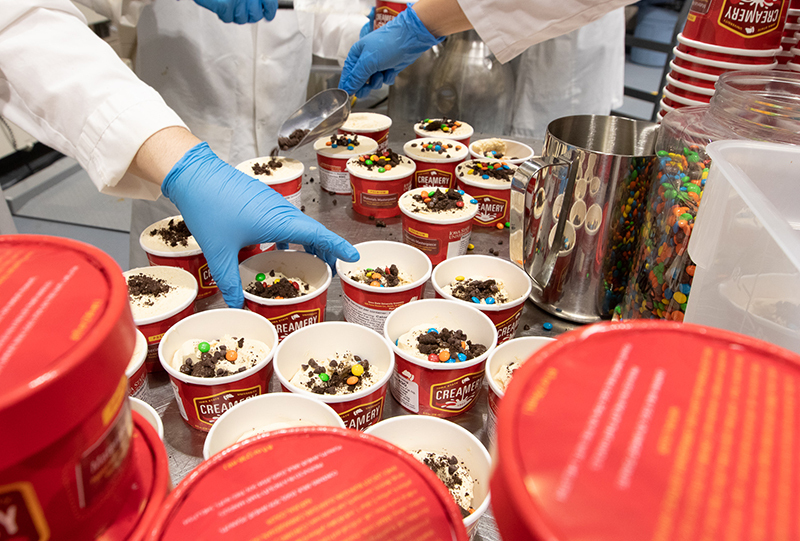
ISU Creamery employees pack 8-ounce cartons of the newest flavor, Materials Masterpiece.
The newest ice cream flavor at the Iowa State Creamery celebrates Ames Laboratory's 75th anniversary as a U.S. Department of Energy facility. "Materials Masterpiece" -- peanut butter ice cream with mini chocolate chips, mini M&Ms and Oreo mix-ins -- emerged from an employee contest in February. Lab employees were the first to enjoy it during their annual picnic last week, and it's available now in the creamery's retail store, 2955 Food Sciences Building, in several options: by the scoop and in pre-packed 8-ounce cups and 32-ounce quarts. It's part of the creamery's regular lineup.
Selecting a flavor
Throughout this anniversary year, Ames Lab employees have participated in a variety of activities to celebrate the 75-year milestone. When an employee suggested a collaboration with the ISU Creamery, Ames Lab hosted a competition for its employees to submit flavor ideas. The challenge: Create an ice cream flavor that tells the story of the lab. ISU Creamery director Stephanie Clark and business administrator Sarah Canova and Ames Lab director Adam Schwartz selected the winning flavor.
The performance management team at Ames Lab proposed it. Their proposal read, in part, "Similar to the development process involved in creating a new material, this recipe requires collaboration, research and bringing together the perfect combination of ingredients to produce the best possible product."
"I have a sweet tooth, so the more mix-ins, the better," said team member Chelsey Aisenbrey, director of laboratory planning and performance. "We wanted to involve a bunch of different toppings that go together to create an even better result.
"This was a nice opportunity to reinforce the story behind the lab," she added.
Return to in-person events brings summer visitors
Most organizations have resumed in-person event schedules, meaning students, faculty and staff will again share campus this summer with thousands of visitors coming for camps, conferences, competitions and other gatherings.
Here's a list of summer events in ISU facilities that are expected to draw 100 or more visitors. Email inside@iastate.edu to suggest any additions we've missed.
|
Event |
Date |
Venues |
Attendance |
|
May 25-28 |
Various* |
7,000 |
|
| Freshman orientation | June 1-30 | Various* | 15,000 |
| Agriculture Credit School | June 6-10 | Scheman Building | 100 |
|
June 12-17 |
Ice Arena* |
150 |
|
|
June 18-19 |
Cyclone Sports Complex |
1,000 |
|
|
Iowa Reading Association and Iowa Association of School Librarians reading conference |
June 21-22 |
Scheman Building |
600 |
|
June 26-29 |
Beyer and State Gym* | 150 | |
| Iowa 4-H Youth Conference | June 28-30 | Various* | 500 |
| Iowa Swine Day | June 30 | Scheman Building | 600 |
| BravO! National Dance Competition | July 5-10 | Stephens Auditorium | 1,500 |
| National Dance Association camp | July 8-12 | Beyer and State Gym* | 160 |
| State Fire School | July 22-24 | Iowa State Center | 800 |
|
July 22-24, 27-31 |
Various |
2,000 first weekend, 18,000 second weekend |
|
| Aug. 8-11 |
Scheman Building |
350 |
*Events also using residence halls.
